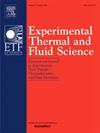Alternative experimental method in investigations of thermal diffusivity of 3D printing material
IF 2.8
2区 工程技术
Q2 ENGINEERING, MECHANICAL
Experimental Thermal and Fluid Science
Pub Date : 2025-05-01
DOI:10.1016/j.expthermflusci.2025.111512
引用次数: 0
Abstract
The paper presents an alternative technique for determining the thermal diffusivity of the material used for 3D printing – PET-G filament. In the study the thermal regular regime method was applied. The presented method based on simple time and temperature measurements allows for accurate and economical determination of thermal diffusivity of 3D printed elements used in various technical applications. Due to the fact that thermal diffusivity is an important thermophysical parameter in the analysis of transient heat transfer processes, knowledge about it is necessary to determine the quality of various types of engineering materials. Such material is the filament used for 3D printing – polyethylene terephthalate glycol-modified PET-G. A review of the latest literature did not reveal any works on the possibility of applying the presented method to the 3D printed materials. The method applied in the investigations made it possible to testing the material in the form directly obtained in the 3D printing process. Spherical test samples printed with the use of the FFF (fused filament fabrication) technology were used. The shape of samples enabled the use of the solution of transient heat conduction equation in a sphere. Three spherical models with different radius were investigated. In order to meet the condition of Bi → ∞, necessary for the assumed hypotheses of the thermal regular regime method, the approximate measurements of heat transfer coefficient and thermal conductivity of the tested material were performed. The results of thermal diffusivity measurements were compared with the results obtained by the classic laser flash method, which was used to measure the thermal diffusivity of the melted down PET-G fiber. The received results of thermal diffusivity: 0.125∙10−6 m2/s for the sample printed from PET-G fiber and 0.137∙10−6 m2/s for the basic material – melted PET-G fiber, indicate the need for the research presented in the work.
3D打印材料热扩散率研究的替代实验方法
本文提出了一种替代技术来确定用于3D打印的材料的热扩散率- PET-G长丝。在研究中,采用了热正则态法。提出的方法基于简单的时间和温度测量,可以准确和经济地确定各种技术应用中使用的3D打印元件的热扩散率。由于热扩散系数是分析瞬态传热过程中一个重要的热物性参数,因此了解它对于确定各类工程材料的质量是必要的。这种材料就是用于3D打印的长丝——聚对苯二甲酸乙二醇酯改性PET-G。对最新文献的回顾没有揭示任何关于将所提出的方法应用于3D打印材料的可能性的作品。在调查中应用的方法使得在3D打印过程中直接获得的形式测试材料成为可能。使用FFF(熔丝制造)技术打印球形测试样品。样品的形状使球体内瞬态热传导方程的求解成为可能。研究了三种不同半径的球面模型。为了满足热规则状态法假设的条件Bi→∞,对被测材料的传热系数和导热系数进行了近似测量。将热扩散系数测量结果与经典激光闪光法测量熔融PET-G纤维的热扩散系数结果进行了比较。得到的PET-G纤维打印样品的热扩散系数为0.125∙10−6 m2/s,基础材料熔融PET-G纤维的热扩散系数为0.137∙10−6 m2/s,表明本工作的研究需要。
本文章由计算机程序翻译,如有差异,请以英文原文为准。
求助全文
约1分钟内获得全文
求助全文
来源期刊

Experimental Thermal and Fluid Science
工程技术-工程:机械
CiteScore
6.70
自引率
3.10%
发文量
159
审稿时长
34 days
期刊介绍:
Experimental Thermal and Fluid Science provides a forum for research emphasizing experimental work that enhances fundamental understanding of heat transfer, thermodynamics, and fluid mechanics. In addition to the principal areas of research, the journal covers research results in related fields, including combined heat and mass transfer, flows with phase transition, micro- and nano-scale systems, multiphase flow, combustion, radiative transfer, porous media, cryogenics, turbulence, and novel experimental techniques.
 求助内容:
求助内容: 应助结果提醒方式:
应助结果提醒方式:


